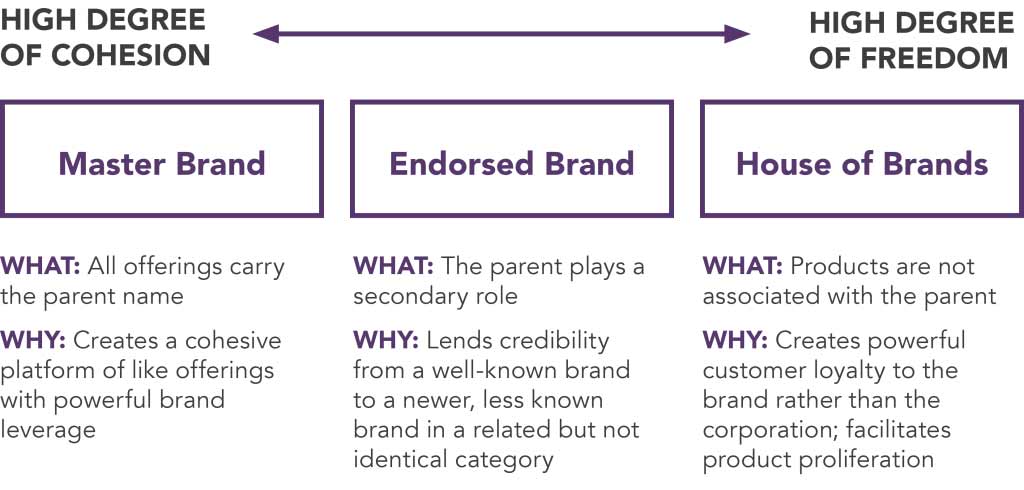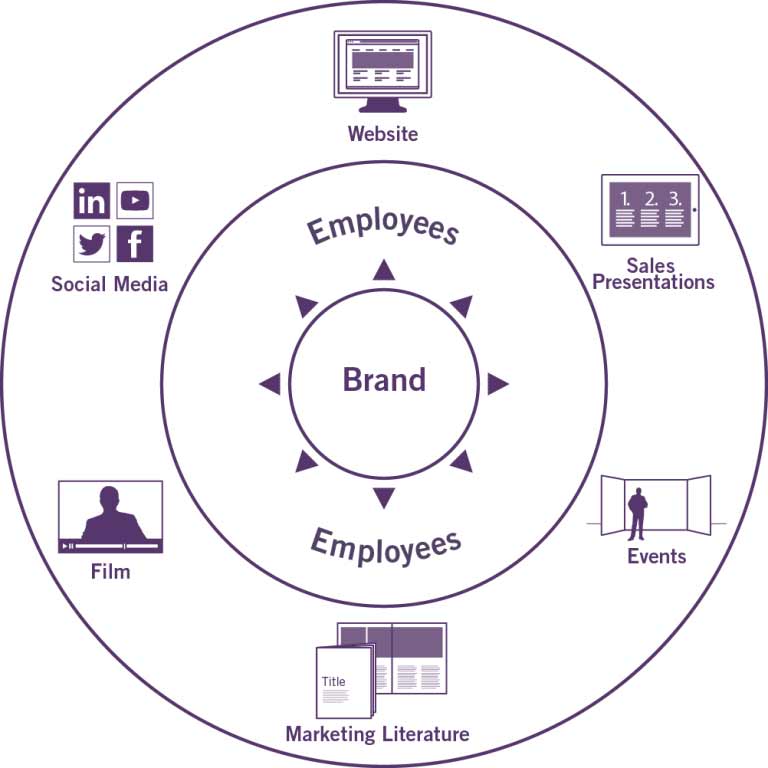According to Harvard Business Review, the failure rate of mergers and acquisitions ranges from 70–90%. Many factors can contribute to the growth or failure of companies being combined. But one underused lever sits at the center of success: brand.
Too often, brand is not championed or leveraged during these critical moments—even though it can provide clarity and inspire unity across essential audiences, reducing risk and accelerating value creation for the new entity.
Why would this be?
Mergers and acquisitions are often viewed from a financial perspective, with more seemingly concrete assets (e.g., real estate, inventory) grounding investors’ perceptions of the deal’s value.
M&A success, however, can hinge on far less tangible factors. Brand can play a critical role in communicating the promise of the merged entity—maximizing the value it creates.
The Value of Brand
A B2B brand is much more than a name, logo or tagline. Brand communicates a company’s unique reason for being and how it meets the needs of customers, investors and employees, differentiating the business from its competition in ways that are compelling and memorable.
Following a merger or acquisition, brand can help a business translate the financial and strategic rationales for a deal into a value proposition that moves the needle by moving people.
How Does Brand Reduce M&A Risk?
The success of a B2B merger or acquisition begins with aligning the brand strategy with the business strategy. By ensuring the visual identity, messaging and experience support business planning, brand invites the people who matter most along a shared journey toward growth.
To achieve this alignment, leadership must first establish a deep understanding of why the merger or acquisition makes financial and competitive sense for both companies, then craft a story that will resonate across:
- Investors
- Prospects
- Customers
- Employees
These critical audiences need reasons to believe that the new entity understands them and will help them meet their challenges.
Given that people remember stories up to 22 times more than they remember facts alone, brand becomes the most relevant, powerful tool for influencing thoughts, feelings and perceptions of the new business.
CarePoint Health: Communicating a Stronger Value Proposition Post-merger
DeSantis Breindel built the brand for New Jersey’s CarePoint Health, created by the merger of three regional hospitals.
Patient research revealed genuine frustration over the complexity of accessing healthcare. And the merger made something new, valuable and truly differentiated possible: simplifying and elevating everyday care across one local, unified system.
- Empathetic messaging affirmed patient priorities: “Top doctors with the skill that really counts. Listening. That’s the point.”
- Caregiver outreach offered the chance to provide hands-on, personalized care—the experience that inspires people to practice medicine in the first place.
Once activated across media and patient and physician journeys, the brand thrived. CarePoint saw a measurable increase in both patient satisfaction and overall care quality, and the brand attracted leading physician groups to become part of its system.
How to Launch Rebranding During M&A
To turn a newly-merged B2B company into a world-class brand, begin by identifying the shared DNA or connective tissue of the pre-merger businesses.
How will two or more companies, successful on their own, bring greater opportunity and value to their clients as a single entity?
Exposing the red thread that links them—not only by what they do, but why they do it—can help inform the combined company’s point of difference and its enhanced value in the market.
An experienced branding partner can be invaluable for unearthing fresh insights into customer needs and partnering with leadership to define the business’s new story.
Often central to that story is the company’s new brand architecture.
What is Brand Architecture in M&A?
When B2B companies grow through acquisition, they often buy market share and extend into adjacent markets.
When these acquisitions are not properly integrated into the parent brand, however, the result is often a portfolio filled with repetitive, contradictory offerings, logos and names (as an expert post-M&A audit can reveal). Salespeople and customers alike can struggle to understand what the new company does and what value it offers.
Brand architecture organizes a business’s portfolio of offerings, clarifying the relationships between brands and sub-brands. In M&A deals, it enables legacy brands to find their new place in relation to one another. This in turn helps investors, prospects and customers understand products’ individual benefits as well as their greater, combined value.
Building clear and cohesive brand architecture is therefore critical for shaping the new company’s marketing efforts and defining its future.
Skipping this step can lead to messaging redundancy, inconsistency and confusion.
How to Build Cohesive B2B Brand Architecture
There are several ways to organize brand architecture, each with its own strengths and providing its own benefits to the business.
The first step is to determine whether businesses and solutions must have a high degree of cohesion or a high degree of freedom. From that foundation, leadership can determine whether to take a Master Brand, Endorsed Brand or House of Brands approach.

Subscribe to Our Newsletter
Once brand architecture is clear, it’s time to design the future of the merged portfolios.
This requires developing deep understanding of customer bases, competitive landscapes and company priorities—then making plans to advance the vision, starting with unifying and galvanizing combined workforces.
How Do We Mobilize Employees From Day One?
The strongest brands are built from the inside out. So, the success of a merger or acquisition rests on winning employees’ hearts as well as their minds.
Employee consideration and support is especially important in B2B companies, where employees represent the most powerful external communications channel. The merging teams experience M&A first—and will represent the new brand every day.
Remember: for this critical audience, the merger or acquisition means one thing: change. Change can be unnerving, so it’s often met with apprehension or even negativity.
A new B2B brand purpose can ease concerns and drive alignment, helping employees leave the past behind and look to the future with energy and optimism. When employees become brand ambassadors, it builds customer trust and shapes what the brand means to them.
If a company fails to articulate a unifying new purpose, the risk is not limited to internal frictions. The business can struggle to shape consistent experiences across external audiences.
For the new entity to succeed, the new brand must be clarified internally, along with the codified behaviors that will bring it to life. This launches the cultural shift that:
- Makes employees feel connected to the deal
- Unifies disparate teams while setting new expectations
- Alleviates concerns and builds confidence
- Inspires engagement and elevated service
Quaker Houghton: Building a Brand to Unite and Inspire Merged Teams from Day One
Quaker Chemical and Houghton International were both leaders in the global industrial fluids market when they announced their merger and became Quaker Houghton. Unifying workforces after a merger or acquisition is always an imperative. But when competitors join forces, the challenge can be complex.
DeSantis Breindel worked with Quaker Houghton to build a new brand that could help internal teams (as well as customers) understand the value created by the merger.
We built upon a key insight: customers expected quality products and great service, but they yearned for expertise about their challenges. They truly valued the human ingenuity behind every solution.
Quaker Houghton’s new tagline, “Forward Together,” positioned the merger as a union of powerful teams—experts so wholly committed to the success of customers that they joined forces to put them first. The company’s new logo symbolized forces coming together to flow in the same direction, while messaging stressed the team’s knowledge, skills and resourcefulness.
In a market often focused on product specs, this spotlight on experienced, dedicated people differentiated the Quaker Houghton brand. It also inspired employees to live the new brand as one united, industry-leading team—one that is recognized and valued for their tireless drive to innovate.
How to Build a Unifying Employer Brand During M&A
An employer brand makes the company’s value to its people clear. In M&A, the goal is to rally combining teams behind leadership’s vision; helping them see how the new brand will help them be more successful motivates them to live the brand in every interaction.
B2B leaders must leverage every communication tool at their disposal to spread understanding and excitement for the new brand. While one-time launch events are extremely important, ongoing messages and experiences reinforce the company’s commitment to the new future.

Once employees’ minds are at ease and their hearts are in the game, they will actually want to connect with the new entity—willingly making the day-to-day changes that are necessary to ensure its success.
To Get Beyond “The Deal,” Leverage Brand to Set Direction
A merger or acquisition will likely happen at some point in the lifespan of any successful B2B company. To maximize value creation and improve chances of success, use brand to set the terms for understanding the value behind the deal—shaping the perceptions and actions of employees, investors, customers and partners.
By following these steps, leaders can use brand to ensure audiences understand—and believe in—the value of the combination:
- Find and articulate the connective tissue between the companies, creating a new brand narrative that resonates across internal and external audiences
- Establish new brand architecture that brings order and clarity to the combined portfolio and signals combined strengths
- Mobilize the workforce to ensure the new brand experience comes to life in sales conversations, service interactions and recruiting
Together, these core components of the post-merger playbook turn integration into momentum.
Never underestimate brand’s ability to make or break the success of an M&A transaction. Value creation accelerates when messaging, architecture and behavior all tell the same story. The identity of the future company becomes clear, and confidence compounds.
Ready to build a brand strategy for M&A success? Let’s talk.
Originally published July 28, 2023.



